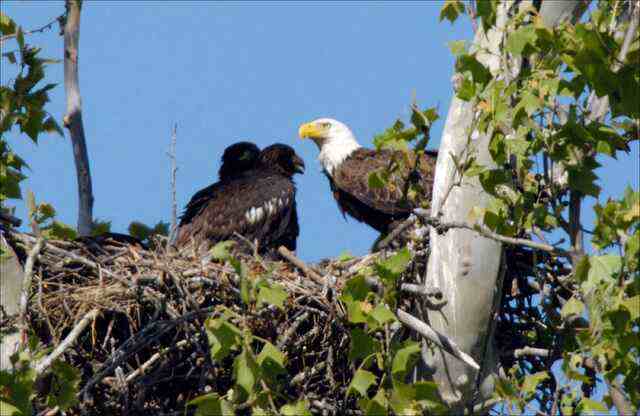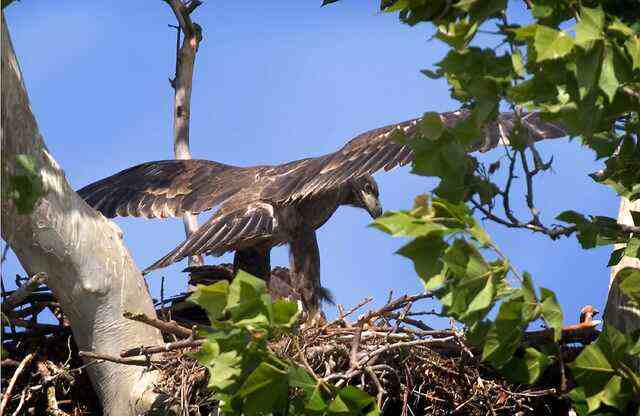Curious about the timing of eagle mating in Maine? Join us as we explore the seasonal courtship of these majestic birds, uncovering when and how eagles mate in the rugged landscapes of Maine. Delve into their fascinating behaviors and the natural wonders of their breeding rituals.
Table of Contents
- 1 Key Takeaways
- 2 When Do Eagles Mate In Maine
- 3 The Life Cycle of Bald Eagles
- 4 Eagle Mating Habits in Maine
- 5 Importance of Understanding Eagle Mating
- 6 Factors Influencing Eagle Mating
- 7 Challenges and Threats to Eagle Mating in Maine
- 8 Conservation Measures and Best Practices
- 9 Research and Monitoring Efforts
- 10 Partnership and Community Involvement
- 11 The Future of Eagle Mating in Maine
- 12 Breeding Season Timing
- 13 Conclusion
- 14 Frequently Asked Questions
- 14.1 How long do eagles stay together after mating in Maine?
- 14.2 Do eagles mate for life in Maine?
- 14.3 Are there specific times of the year when eagles are more likely to mate in Maine?
- 14.4 What are some challenges that eagles face during the mating season in Maine?
- 14.5 How can individuals and communities in Maine support and protect eagle mating habitats?
- 15 Author
Key Takeaways
- Eagle mating in Maine occurs during the early spring months, with the peak in March and April.
- Factors like climate change, habitat loss, and human disturbance impact eagle mating success.
- Protecting nesting sites is important to prevent disturbances and destruction during the breeding season.
- Ongoing monitoring and research are necessary for tracking population trends and identifying potential threats to mating success.

When Do Eagles Mate In Maine
Eagles typically mate in Maine from late December to early January, with nesting activity starting one to three months before the female lays eggs. However, the exact timing can vary depending on the location and weather conditions.
Eagles tend to mate for life, and if one partner dies, the other quickly finds a new mate if one is available. If you’re interested in viewing eagles during mating season, it’s important to observe them from a safe distance to avoid disturbing their natural behavior.
The Life Cycle of Bald Eagles
The life cycle of bald eagles encompasses various stages from hatching to fledging, including the processes of courtship, mating, nest-building, egg-laying, incubation, and rearing of the young.
During the bald eagle breeding season, which typically occurs from January to March in Maine, courtship behavior becomes more pronounced.
Male eagles engage in impressive aerial displays, swooping and diving to attract a mate. They also perform intricate calls and territorial flights to establish their dominance.
Once a pair has formed, they engage in a series of courtship rituals, such as locking talons mid-air and performing acrobatic displays, strengthening their bond.
After successful courtship, the eagles select a suitable nesting site and begin constructing their nest, which can be as large as 8 feet in diameter.
This nesting process is an important precursor to eagle mating habits in Maine, as it provides a secure environment for the eagles to lay and incubate their eggs.
Eagle Mating Habits in Maine
In Maine, the mating habits of eagles are observed during a specific season. Eagle breeding patterns in Maine typically occur between the months of January and February. During this time, eagles engage in courtship behavior, which includes aerial displays, vocalizations, and intricate flight patterns.
These courtship rituals are essential for pair bonding and mate selection. Male eagles will often perform impressive aerial acrobatics to impress the females, while the females evaluate the males’ fitness and suitability as potential mates.
Understanding eagle mating habits is crucial for conservation efforts and the management of their populations.
By studying their breeding patterns and courtship behavior, researchers can gain insights into the health and stability of eagle populations in Maine.
This knowledge can inform conservation strategies and help protect these majestic birds for future generations to enjoy.
Importance of Understanding Eagle Mating
Crucial for the conservation of eagle populations, the understanding of their mating habits provides valuable insights into the health and stability of these majestic birds in Maine, enabling informed conservation strategies for future generations to cherish.
To gain a comprehensive understanding of eagle behavior, researchers focus on studying their mating season. This research involves observing and documenting the timing, courtship displays, and territorial behaviors of eagles during their mating period.
By understanding when eagles mate in Maine, researchers can identify factors that may influence their breeding success, such as climate change, habitat loss, and human disturbance.
This knowledge allows conservationists to develop targeted interventions and management plans to mitigate these threats and promote successful breeding outcomes.
Transitioning to the subsequent section on factors influencing eagle mating, it is important to examine the various ecological and environmental aspects that impact their reproductive success.

Factors Influencing Eagle Mating
Factors such as climate change, habitat loss, and human disturbance significantly impact the reproductive success of eagles. These factors influence various aspects of eagle behavior, including their mating rituals and courtship displays.
Climate change can alter the availability of prey, affecting the eagles’ ability to find sufficient food resources for themselves and their offspring.
Habitat loss due to human activities, such as deforestation and urbanization, can reduce the availability of suitable nesting sites and disrupt the eagles’ mating behavior.
Additionally, human disturbance, such as noise and disturbance near nesting areas, can disrupt courtship displays and lead to failed breeding attempts.
Understanding these factors is crucial for developing conservation strategies to address the challenges and threats to eagle mating in Maine.
Challenges and Threats to Eagle Mating in Maine
Threats to the successful mating of eagles in Maine include climate change, habitat loss, and human disturbance. These challenges for eagles pose significant threats to their ability to mate and reproduce successfully.
Climate change impacts the availability of suitable nesting sites and alters the timing of prey availability, potentially disrupting the eagles’ breeding season.
Habitat loss due to human activities, such as deforestation and urbanization, reduces the availability of suitable nesting habitats and foraging grounds for eagles.
Human disturbance, including recreational activities and noise pollution, can disrupt eagle courtship behaviors and nesting activities.
To highlight these challenges, the following table provides an overview of the threats to eagle mating in Maine:
| Threats to Eagle Mating |
|---|
| Climate Change |
| Habitat Loss |
| Human Disturbance |
These threats necessitate the implementation of conservation measures and best practices to protect and support eagle populations in Maine.
Conservation Measures and Best Practices
The conservation measures and best practices for eagle mating in Maine include protecting nesting sites, educating the public, and collaborating with wildlife agencies.
Protecting nesting sites is crucial for ensuring the safety and success of eagle mating, as disturbances or destruction of nests can lead to breeding failures.
Educating the public about the importance of eagle conservation and the need to respect nesting areas is essential in reducing human disturbances and promoting responsible behavior.
Collaborating with wildlife agencies allows for coordinated efforts in monitoring and managing eagle populations, implementing conservation measures, and addressing any potential threats or challenges that may arise.
Protecting Nesting Sites
To ensure the preservation of eagle nesting sites in Maine, it is essential to establish safeguards that shield the sanctity of these locations and foster a conducive environment for successful mating.
Protecting nesting sites is a crucial component of conservation efforts aimed at maintaining the eagle population.
This involves identifying and designating key nesting areas as protected habitats, where human activity is limited or regulated.
Such measures prevent disturbance and destruction of nests during the critical breeding season.
Additionally, conservation organizations work towards restoring and enhancing nesting sites by providing suitable nesting materials and creating artificial platforms to encourage eagles to nest in safe locations.
By implementing these protective measures, the chances of eagle mating success are significantly improved, supporting the growth and sustainability of the population.
Moving forward, educating the public about the importance of protecting nesting sites will further contribute to the overall conservation efforts.
Educating the Public
Protecting nesting sites is crucial for the conservation of eagles in Maine. However, it is equally important to educate the public about the significance of these sites and the behaviors of eagles during the mating season.
Public awareness is essential for fostering a sense of responsibility and respect towards these majestic birds and their habitats.
To achieve this, educational programs play a vital role in disseminating accurate information and dispelling any misconceptions.
These programs can include interactive workshops, informative brochures, and engaging presentations that highlight the unique behaviors and needs of eagles during their mating season.
By increasing public awareness through these educational initiatives, individuals can make informed decisions and actively contribute to the protection of nesting sites.
Transitioning into the subsequent section about collaborating with wildlife agencies, it is important to explore the efforts made by these agencies to further enhance the conservation of eagles.
Collaborating with Wildlife Agencies
Collaboration with wildlife agencies results in a robust network of experts and organizations working together to enhance the conservation efforts for nesting sites of eagles in Maine. This collaboration is crucial for implementing effective wildlife management strategies and ensuring the preservation of suitable habitats for eagles.
Here are some key elements of this collaborative effort:
- Sharing of knowledge and expertise: Wildlife agencies pool their knowledge and expertise to develop comprehensive management plans for eagle nesting sites.
- Monitoring and research: Collaborative efforts involve conducting regular monitoring and research to understand the population dynamics of eagles and their habitat requirements.
- Habitat preservation: Wildlife agencies work together to identify and protect critical nesting habitats, implementing measures to prevent disturbance and destruction.
- Public education and outreach: Collaborative efforts also focus on educating the public about the importance of eagle conservation and promoting responsible behavior around nesting sites.
These collaborative initiatives lay the foundation for effective research and monitoring efforts, which will be discussed in the subsequent section.
Research and Monitoring Efforts
Research and monitoring efforts in Maine aim to shed light on the timing of eagle mating, without the interference of personal biases or opinions. These efforts are driven by the desire to understand the reproductive behavior of eagles in order to better manage and conserve their populations.
Through rigorous research findings and long-term monitoring, scientists have been able to identify population trends and gain insights into the mating patterns of eagles in Maine.
These studies have revealed that eagle mating typically occurs during the winter months, with peak activity observed in January and February.
The research findings also indicate that the timing of eagle mating may be influenced by environmental factors such as temperature and food availability.
Such scientific investigations provide valuable knowledge for wildlife agencies and conservationists, enabling them to develop effective strategies for the protection and preservation of eagle populations in Maine.
Transitioning into the subsequent section about partnership and community involvement, these research efforts are further enhanced through collaboration with various stakeholders.

Partnership and Community Involvement
This paragraph will discuss the subtopic of partnership and community involvement in the context of research and monitoring efforts.
Citizen science initiatives play a crucial role in engaging the general public in scientific research and data collection, allowing for a larger scale of data gathering and analysis.
These initiatives provide opportunities for individuals to actively participate in data collection, contributing to a greater understanding of various ecological phenomena.
Additionally, volunteer opportunities within research and monitoring projects facilitate community engagement and foster a sense of stewardship towards the environment, promoting a collaborative approach to conservation efforts.
Citizen Science Initiatives
One notable approach to gathering data on eagle mating patterns in Maine is through citizen science initiatives. These initiatives engage the community in data collection, allowing volunteers to contribute to scientific research.
Through these programs, individuals can participate in various activities such as monitoring eagle nests, recording behaviors, and collecting data on nesting success.
Citizen science initiatives provide a valuable opportunity for community engagement and education, fostering a sense of stewardship for the local environment.
By involving the public, a larger amount of data can be collected over a wider geographic area, providing a more comprehensive understanding of eagle mating patterns in Maine.
Furthermore, these initiatives promote a sense of empowerment and ownership among participants, as they actively contribute to scientific knowledge.
Transitioning into the subsequent section about volunteer opportunities, individuals interested in getting involved can explore various ways to contribute to eagle conservation efforts.
Volunteer Opportunities
Volunteer opportunities abound for those interested in actively participating in the conservation of eagles in Maine, allowing individuals to contribute to the preservation of these majestic birds and their natural habitat.
Community engagement plays a vital role in these initiatives, as volunteers work together to monitor eagle populations, collect data, and raise awareness about the importance of eagle conservation.
In addition to fostering a sense of community, volunteer programs also provide training opportunities, ensuring that participants have the knowledge and skills needed to effectively contribute to the cause.
Through volunteer training, individuals learn to identify eagle nests, monitor breeding behaviors, and assist in habitat restoration efforts.
By actively engaging in these volunteer activities, individuals not only contribute to the preservation of eagles in Maine but also gain a deeper understanding of these fascinating birds.
Looking ahead, understanding the future of eagle mating in Maine requires a comprehensive examination of various factors, including climate change and habitat availability.
The Future of Eagle Mating in Maine
The future of eagle mating in Maine holds significant implications for the state’s wildlife conservation efforts. As the population of eagles continues to grow, future challenges arise in ensuring suitable habitats for mating.
The increasing number of eagles requires a sufficient availability of nesting sites and an abundant food supply.
Conservationists must also consider the impact of climate change on eagle mating patterns, as changing temperatures and weather patterns can affect the timing and success of mating.
Protecting eagle mating habitats and implementing measures to mitigate the effects of climate change will be essential in ensuring the continued success of eagle mating in Maine.
Understanding these future challenges and taking proactive measures will help preserve the iconic species and maintain the delicate balance of Maine’s ecosystems.
Transitioning into the subsequent section about frequently asked questions about eagle mating in Maine, it is important to address the various aspects of this fascinating process.
Breeding Season Timing
An understanding of the intricacies of eagle mating in Maine can be obtained by addressing frequently asked questions related to this natural phenomenon.
Eagle mating behavior is a fascinating subject, as it involves intricate displays, complex courtship rituals, and precise timing.
The breeding season timing for eagles in Maine typically occurs in the early spring, around March or April.
During this time, eagles engage in elaborate courtship displays, which include aerial acrobatics, vocalizations, and nest-building activities.
These behaviors are essential for pair bonding and selecting a suitable nesting site. Once the pair has formed, they engage in copulation, which typically takes place on or near the nest.
The female then lays one to three eggs, which both parents take turns incubating.
Understanding the intricacies of eagle mating behavior and breeding season timing is crucial for conservation efforts and ensuring the continued success of these magnificent birds. By studying and protecting their habitats, we can help maintain healthy eagle populations in Maine.
Conclusion
To truly safeguard the splendor of these soaring creatures, proactive preservation of their habitats and diligent monitoring is imperative.
The importance of research in eagle mating cannot be overstated in our efforts to conserve and protect these majestic birds.
By studying their mating behaviors, scientists can gain valuable insights into their reproductive patterns, nesting habits, and overall population health.
This information is crucial for implementing effective conservation strategies and ensuring the continued success of eagle populations in Maine.
Conservation efforts for eagle mating should focus on:
- Preserving their nesting sites
- Protecting their habitats from human disturbances
- Minimizing the use of harmful pesticides that can affect their reproductive abilities
Additionally, ongoing monitoring and research are essential for tracking population trends and identifying potential threats to their mating success. By prioritizing these efforts, we can contribute to the long-term survival and thriving of eagles in Maine.

Frequently Asked Questions
How long do eagles stay together after mating in Maine?
The length of the eagle mating season in Maine varies depending on environmental factors such as food availability and weather conditions. Factors affecting eagle mating success include territory quality, competition, and the health of the individuals involved.
Do eagles mate for life in Maine?
Eagle mating behaviors and rituals are complex and fascinating. They involve elaborate courtship displays, aerial acrobatics, and intricate nest-building. In Maine, eagles are known to form long-lasting pair bonds, suggesting that they may mate for life.
Are there specific times of the year when eagles are more likely to mate in Maine?
Eagle mating behavior and nesting habits in Maine are influenced by seasonal variations. Eagles are more likely to mate during the winter and early spring months when they establish and maintain their nesting territories.
What are some challenges that eagles face during the mating season in Maine?
During the mating season, eagles in Maine face various challenges. These include competition from other eagles for mates and territories, finding suitable nesting sites, and ensuring successful reproduction amidst unpredictable weather conditions and limited food availability.
How can individuals and communities in Maine support and protect eagle mating habitats?
Community involvement is crucial in supporting and protecting eagle mating habitats in Maine. By actively participating in habitat preservation efforts, such as conserving natural areas and minimizing human disturbance, individuals and communities can contribute to the long-term success of eagle populations.





